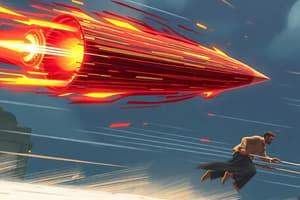Podcast
Questions and Answers
Projectile motion follows a ______ path, which is a curved trajectory.
Projectile motion follows a ______ path, which is a curved trajectory.
parabolic
The initial velocity is a ______ quantity, having both magnitude and direction.
The initial velocity is a ______ quantity, having both magnitude and direction.
vector
Air resistance is a force that opposes the ______ of the projectile.
Air resistance is a force that opposes the ______ of the projectile.
motion
The range of the projectile is the horizontal distance from the point of projection to the point where the projectile ______.
The range of the projectile is the horizontal distance from the point of projection to the point where the projectile ______.
The maximum height of the projectile is the highest point reached by the projectile above the point of ______.
The maximum height of the projectile is the highest point reached by the projectile above the point of ______.
The angle of projection is the angle at which the projectile is ______.
The angle of projection is the angle at which the projectile is ______.
Flashcards are hidden until you start studying
Study Notes
Trajectories
- Projectile motion follows a parabolic path, which is a curved trajectory.
- The trajectory is symmetrical about the vertical line passing through the maximum height.
- The shape of the trajectory depends on the initial velocity and angle of projection.
Initial Velocity
- Initial velocity is the velocity at which the projectile is projected.
- It is a vector quantity, having both magnitude and direction.
- The initial velocity can be resolved into horizontal and vertical components:
- Horizontal component: V₀cosθ
- Vertical component: V₀sinθ
Air Resistance
- Air resistance is a force that opposes the motion of the projectile.
- It depends on the shape, size, and velocity of the projectile, as well as the density of the air.
- Air resistance can be neglected for small, compact projectiles moving at moderate velocities.
Range and Maximum Height
- Range: The horizontal distance from the point of projection to the point where the projectile lands.
- Maximum height: The highest point reached by the projectile above the point of projection.
- Range (R) can be calculated using the formula: R = (V₀²sin2θ) / g
- Maximum height (H) can be calculated using the formula: H = (V₀²sin²θ) / (2g)
Angle of Projection
- The angle of projection is the angle at which the projectile is launched.
- It affects the range and maximum height of the projectile.
- The angle of projection can be optimized to achieve the maximum range:
- For maximum range, the angle of projection is 45°.
- For angles less than 45°, the range increases as the angle increases.
- For angles greater than 45°, the range decreases as the angle increases.
Studying That Suits You
Use AI to generate personalized quizzes and flashcards to suit your learning preferences.




